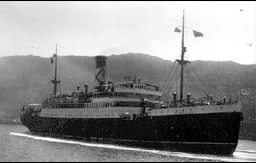Nerissa A Canadian Tragedy
John Skuce
In wartime naval parlance, Nerissa was a “lucky ship.” By April 1941 she had successfully completed her 39th crossing of the North Atlantic. Not that there weren’t anxious moments. On her 39th crossing from Britain to Canada she encountered an eastern bound convoy at the precise moment a U-boat was making its attack. By bizarre chance one torpedo ran up her port side and another up her starboard side on their malevolent path of destruction. Later on the same day a U-boat surfaced and engaged her in a gun battle, which Nerissa ended by outrunning the German. Nerissa was a “lucky ship.”
Nerissa’s Glasgow builders had endowed her with a feature that in time would be her undoing, speed. Built as a combination freighter and passenger vessel for the Liverpool / St. John’s trade, she was endowed with a maximum speed of 17 knots and a comfortable cruising speed of 14 knots. In late 1939 the 5,583-ton Nerissa was modified to serve as an auxiliary transport with accommodations for 250 men and she was fitted with a 4″ naval gun and a Bofors gun for self-defense. Crews to man the defensive armament were drawn from the Maritime Regiment of the Royal Artillery. Due to her superior speed over the matronly 9-knot pace of escorted convoys, Nerissa was deemed capable of outrunning any dangers posed by enemy submarines and, therefore she would sail alone.
The 40th wartime crossing for Nerissa began on April 21, 1941 at the port of Halifax. The previous evening 145 Canadian servicemen along with R.A.F., R.N.A.F. personnel, Northern Electric technicians, members of the press and a number of British civilians had boarded in preparation for the early morning departure. On the morning of April 21 she weighed anchor and sailed from the Bedford Basin as a member of a Britain bound convoy. At 10:15 a.m. she acknowledged the escort’s signal, “God speed and God bless” and broke off from the convoy to make her solitary run. On April 23 she dropped anchor at St. John’s, Newfoundland, her Captain G. Watson received his Admiralty orders and she sailed for Britain on the evening tide.
For 7 days Nerissa ploughed her way eastward, the almost idyllic time broken only by daily lifeboat drill and the occasional “stand to” for the gun crews. On April 30 she entered the patrol area of Royal Navy Coastal Command aircraft whose duty was to ensure that lurking submarines were located, reported and dealt with.
As darkness descended a Hudson patrol aircraft flew over and signaled by Aldis lamp that the area was clear of U-boats. At 11:30 p.m. the first torpedo struck amidships. Immediately the auxiliary transport began to settle and the passengers calmly donned lifejackets and went to their assigned lifeboat stations as though taking part in a drill. Boats were filled and in the process of being lowered when catastrophe struck. A tremendous explosion ripped the foundering ship in two, splintering the partially lowered boats and sending a geyser of wreckage and water hundreds of feet into the air. The U-boat to ensure the completeness of its kill had fired an additional two torpedoes which struck and exploded simultaneously. Within 4 minutes of the first strike Nerissa was gone. In the brief interval between the first torpedo and oblivion, the ship’s telegrapher whose name history unfortunately does not record, was able to send an S.O.S. and the position of 10° 08′ W, 55° 57′ N.
The survivors spent a harrowing night in the near freezing Atlantic and were first hand witnesses to the effects of shock and hypothermia as man after man slipped beneath the surface. At first light a British Blenheim appeared and circled the flotsam of the sunken transport and at 7:50 a.m. two British destroyers appeared on the scene, H.M.S. Veteran and H.M.S. Hunter. While Hunter circled the area Veteran proceeded to pick up survivors. The 84 men who had survived the sinking and the night in the frigid waters were sped the 200 miles to Londonderry, Ireland, where they were distributed among several hospitals to ensure immediate and maximum care.
“Lucky Nerissa” had gone to her nautical Valhalla taking with her 83 Canadian servicemen, virtually an entire graduating class of R.A.F. British Commonwealth Air Training Program pilots, 3 pilots of the Royal Norwegian Air Force, 11 American ferry pilots and 43 members of auxiliary organizations artillerymen, civilians and crew. Canadians should well remember Nerissa for she has the distinction of being the only transport carrying Canadian troops to be lost during Hitler’s war.
Sources:
R.C.M.P. Quarterly Vol. 9 No. 1 (July 1941)
D.N.D. Directorate of History: “The Sinking of S.S. Nerissa” J.L Saull
D.N.D. Directorate of History: “39” G.S. EDGERTON-Bird
D.N.D. Directorate of History: Report of Sinking of Nerissa H.C. Ledsham
Stacey, C.P. “Six War Years” Pg. 193-4
Commonwealth War Graves Commission
Note:
Postwar examination of Kreigsmarine documents and logs conclusively attributes the sinking of S.S. Nerissa to U-552 under the command of Erich Topp. Topp and U-552 claimed notoriety by torpedoing and sinking the American destroyer Reuben James on October 31,1941, over a month before the United States’ entry into the war. Erich Topp survived the war and is acknowledged as the third top scoring U-boat commander having sunk 34 Allied merchant ships with a gross displacement of 193,684 tons. Erich Topp was recalled from active service in 1943 to serve as an instructor and subsequently was given command of U-2513 in 1945, he surrendered his boat to the British at the conclusion of hostilities. His original command U-552 was reassigned to another commander and she continued her remarkable career which spanned 4 years and 5 months of active service. U-552 was scuttled by her crew on May 2, 1945 at Wilhelmshaven to avoid capture.

